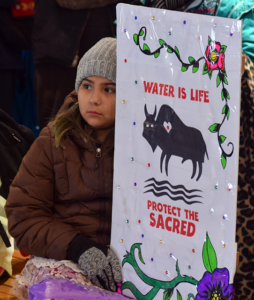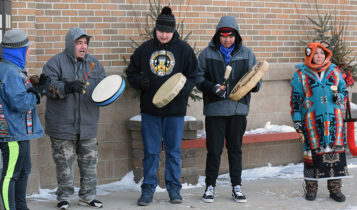BEMIDJI- The Bemidji State University American Indian Resource Center, Deer River High School Ogichiidaag Club and other allies joined together Friday, January 18th in Bemidji for the Indigenous Peoples Movement March.
Friday’s event was held simultaneously with a national march in Washington, DC. The march aimed to highlight problems affecting Indigenous communities across the world. Issues the movement hoped to bring awareness to include: voter suppression, divided families, environmental protection efforts and the Missing, Murdered Indigenous Women (MMIW) movement. The national march defined itself as a grassroots effort between coordinators at all levels from activists, influencers, youth, to state and tribal leaders.
The Bemidji march began at Paul and Babe and ended at the American Indian Resource Center on the Bemidji State University campus. Despite the freezing temperatures the walk had many participants-including many students from the surrounding high schools.
Bemidji State University Recruiter Sage Davis, who organized and coordinated the Bemidji event says bringing the march to Bemidji was a collaborative effort between the community and educational institutions in the area. Davis hopes the march will not only bring attention the issues but also will help show students how higher education can help them make a difference in their communities.

“I’m excited to be a part of this movement that’s happening, it was an idea that was brought to me by my sister and her students from the Deer River High-School. They wanted to participate in this moment that’s happening all across the nation. There are 12 other marches that are happening this week. I think it says a lot too that we’re here in Bemidji, Minnesota—a small town. That we’re to be able to come together and show our love and support for everyone,” says Davis.
Davis believes the issues that the march is aiming to highlight aren’t ones that many who are involved within the community are unfamiliar with, but they are issues that the wider population need to start taking an interest in.
“A lot of people know why we’re here today. It has to do with being a family. There are a lot issues happening right now that are affecting Indigenous people. We have people at the border seeking asylum who are being met with violent forces, our waters are being poisoned by pipelines and oil companies are coming through our land wanting to dig up our mother earth. The MMIW Movement–we (Indigenous Women) are the most likely to be kidnapped or trafficked and one of the leading causes of Native American Women’s death is murder. That is a call for help not only for Indigenous People but for our allies. We need everyone’s help to call attention to these issues,”
Deer River High School Cultural Arts Teacher, Lavender Hunt who led her students in Friday’s march, says her students have been passionate about being involved in the movement and making their voices heard after hearing about the march from a guest lecturer at school.
“My friend Jen, who is one of the DC March organizers emailed me about this movement prior, and I asked her to come talk to my students about it. She talked about the different issues and the experiences she had during Standing Rock and my students were really inspired and motivated by it. They knew they didn’t have the funds to go to Washington DC, so they were like, what can we do? How can we participate? She advised us to host a solidarity march. We’ve been busy working on signs, and our flag. We have over 550 Native American Students at our school now and our administrators have been really supportive about the cultural education and curriculum we’ve been teaching. What we’ve been finding is that the cultural education has been awakening our student’s self-identity in being Anishinaabe and showing them how important learning your about culture and that way of life is.”
Hunt says it’s important for students to be given the chance to find their cultural identity and talk about these issues in an education setting. Even more so that administration and adults are supportive of students doing so.
“It says a lot to our children to be here today. There’s a lot of teachings in motion here. All of the schools and education programs that came forward to be here is really fantastic. As Anishinaabe people we don’t just walk in one world, and we want to come together today and show everyone what a beautiful red road we live as Anishinaabe people,” said Hunt.

Following the march, high school students from Remer, Deer River, Bagley, Trek North and Bemidji were given the chance to speak in front of attendees and share why they chose to walk. Xavier, a senior from Bemidji High School who is a member of the schools “Seventh Generation” group took the stand to represent his classmates.
“We chose to walk today to bring pride to our ancestors. I myself, come from Seminole-Lenape and Dakota people. We want to show those like my little brothers and my younger classmates that it’s okay to feel pride for your indigenous ancestors. It’s okay to feel empathy for those down south and for those who are cold and hungry.”
Many of the students who attended the march were accompanied by staff from their respective schools and all were given the opportunity to ask Native professors from the university questions directly about their programs while enjoying a meal provided by the American Indian Resource Center.
Bemidji State University AIRC Director Bill Blackwell says there was no hesitation about the AIRC’s involvement and that giving the students a platform to speak on issues in Indian Country is always a goal for the center.
“The AIRC gets asked to do a lot of different events and this was one we felt fit into our mission really well. Anything we can do to bring in potential students and community members is a good thing. We want even our current students to understand that when there are issues on the national scene as far as Indian Country is concerned—BSU and the AIRC will be reactive to it”
Blackwell says giving the students the chance to speak in front of their community is one of the ways the AIRC aims to meet goals regarding Native American student needs.
“One of the things we try hard to focus on is the recruitment and retention of Native American students. Recruitment events at the AIRC aren’t just having students on campus to take a tour and have them see the facilities. It’s about days like today, where it’s an event that’s close and personal to them. It’s days like our quiz bowl—where we invite students to campus to compete in cultural and language questions. It’s very meaningful to us. We want to be known as a school that’s a destination college for American Indian students, and you don’t get to that point without having events like today, where students are allowed to express themselves and are given a platform to talk about things in Indian Country.
To learn more about the Indigenous Peoples’ Movement Day March, you can visit http://indigenouspeoplesmovement.com

